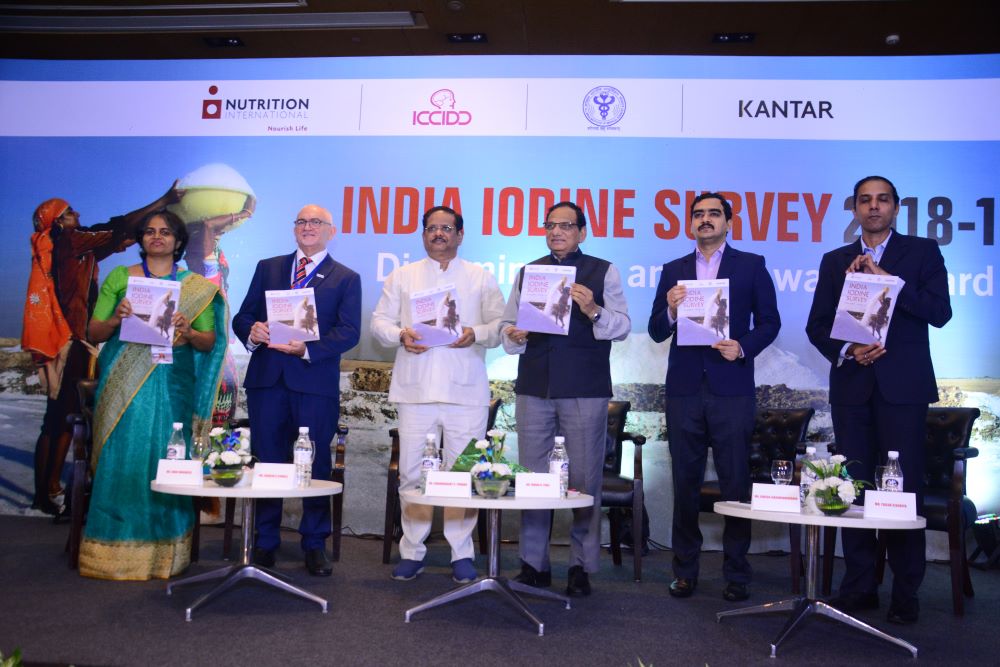Field Stories
Ten inspiring global nutrition stories
December 17, 2024
WP_Term Object
(
[term_id] => 48
[name] => News
[slug] => all-news
[term_group] => 0
[term_taxonomy_id] => 48
[taxonomy] => news-category
[description] => Stay up to date on our announcements, newest projects and partnerships, and news about how we’re making a difference in the lives of people around the world.
[parent] => 0
[count] => 272
[filter] => raw
)
Nutrition International and partners disseminate results of India Iodine Survey 2018-19
Posted on September 17, 2019


NEW DELHI: On September 9, Nutrition International released the results of the India Iodine Survey 2018-19, a nationwide study to estimate the iodine status of the population and assess the extent to which Indian households have access to adequately iodized salt.
The survey, conducted in collaboration with the All India Institute of Medical Sciences New Delhi, the Association for Indian Coalition for the Control of Iodine Deficiency Disorders, and Kantar, reveals that 76.3% of Indian households consumed adequately iodized salt (or salt with more than or equal to 15 parts per million of iodine) as per World Health Organization guidelines. The results support the need to sustain and step up efforts to achieve Universal Salt Iodization (USI), or 90% of households consuming iodized salt.
Iodine is a vital micronutrient needed regularly in small quantities for optimal mental and physical development. Iodine deficiency is most damaging during fetal development and the first years of a child’s life, and can result in stunted growth and mental impairment. Children born in iodine deficient areas may have up to 13.5 IQ points less than those born in iodine sufficient areas.
“The India Iodine Survey, 2018-19 comes at a crucial time when the entire country is celebrating Poshan Maah,” said Dr. Vinod Paul, Member (Health and Nutrition), NITI Aayog, a policy think tank of the Government of India. “The results show that industry regulators, state and central government and other stakeholders have played a critical role in the success so far. It is now time for us to step up our efforts to achieve full universal salt iodization by 2022. The survey is a very good effort to scientifically estimate the progress so far and we need to accelerate progress in states that are facing challenges. I would be happy to organize a meeting of the stakeholders and states at the NITI Aayog to take this discussion forward and devise a strategy to achieve USI by 2022.”
The survey, carried out with the support of the Government of Canada through Global Affairs Canada, was conducted across all 29 states and 7 Union Territories and included a total of 21,406 households. Results showed that in the states of Jammu & Kashmir, Manipur, Mizoram and Nagaland, more than 99% of households have access to adequately iodized salt. In addition, 13 out of 36 states have already achieved USI.
“For more than 20 years Nutrition International has been working with the Government of India and partners to eliminate iodine deficiency disorders and we are proud of the progress we have collectively made to reduce the risk of iodine deficiency disorders across the country,” said Andrew O Connell, Nutrition International’s Regional Director, Asia. “We are confident that the results from the India Iodine Survey 2018-19 will guide policy decision and interventions needed to sustain the progress and step up efforts to reach USI.”
Based on survey findings, the experts present at the dissemination urged the government to develop a more contextual and state-specific approach to improve coverage of iodized salt with greater focus on enforcement and monitoring. Along with generating more awareness about consumption of adequately iodized salt, the survey also reveals the need to promote production and supply.
The survey results were released by Dr. Vinod Paul, Member (Health and Nutrition), NITI Aayog, Government of India along with Dr. Chandrakant S. Pandav, President, Association for Indian Coalition for Control of Iodine Deficiency Disorders & Former Professor & Head, Centre for Community Medicine, All India Institute of Medical Sciences, New Delhi, Nutrition International Regional Director, Asia, Andrew O’Connell and Mini Varghese, Acting India Country Director, Nutrition International.
The dissemination was attended by over 100 participants from the Ministry of Health and Family Welfare, NITI Aayog, Food and Drugs Control Administration, Iodine Deficiency Disorders (IDD) Cell, salt processors, development partners, doctors, academicians from leading research organizations and media.
Key findings: